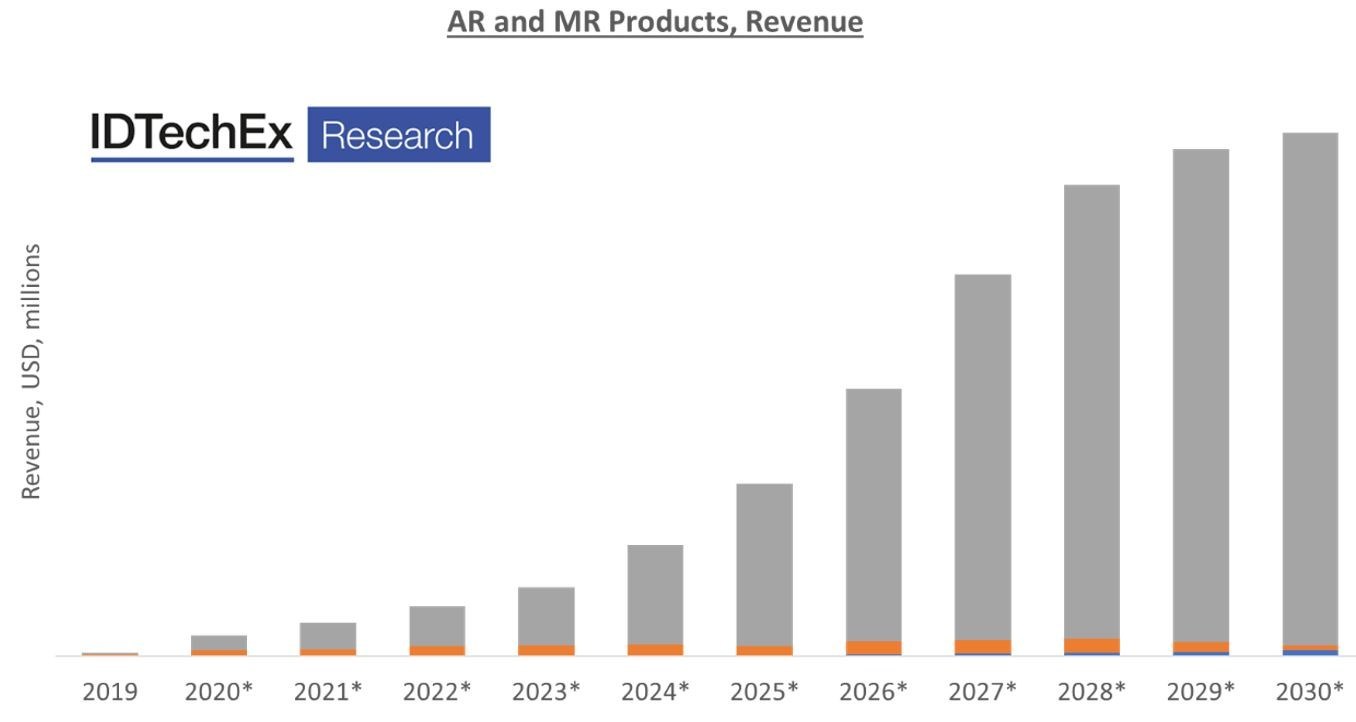Augmenting healthcare with Augmented Reality
Augmented Reality and Mixed Reality are being used more and more in hospitals by doctors and healthcare professionals to provide them with a hands-free working environment, greater flexibility with overlaying information and processing information from its camera. IDTechEx predicts this market to be over $20bn. IDTechEx's report on 'Augmented, Mixed and Virtual Reality 2020-2030' provides a detailed overview of this sector.
Augmented Reality (AR) and Mixed Reality (MR) are just one part of the 'Spatial reality' family. The other member of this family is Virtual Reality (VR). IDTechEx predicts the AR/VR/MR market to be over $30bn by 2030, and part of this will come from the uptake of such devices used in these high impact cases.

What is Augmented Reality/Mixed Reality?
Different companies have different naming classifications for their products. Some call their products mixed reality or merged reality, even though the superimposed images do not interact spatially with the real world, some replace augmented with applied reality. Some companies call their product augmented reality when the product has an opaque video display and, therefore, does not 'augment' the real world.
There are typically two terms for spatial reality devices where the user can see the real world.
- Augmented Reality (AR). These devices overlay digital content on top of the real world.
- Mixed Reality (MR). These devices add superimposed digital content that superficially interacts with the environment in real time.
Different headsets fulfill different requirements - but most augmented and mixed reality products currently cater to an enterprise audience over a consumer market, but this will change in the future. With improvements in technology and design, augmented reality and mixed reality will continue to grow to a market of over $20bn by 2030.
What are some examples of Augmented/Mixed Reality in healthcare?
Recently the versatility of mixed and augmented reality products has come to the forefront of the news, with an Imperial led project at the Imperial College Healthcare NHS Trust. Doctors have been wearing the Microsoft Hololens headsets whilst working on the front lines of the COVID-19 pandemic, to aid them in their care for their patients.
COVID-19 has put the spotlight on this hands-free, interactive technology, and it is unlikely that this focus will move for some time. There will be a need for this technology in many new use cases, which previously did not require hands-free, or remote capabilities.
Another example is allowing a surgeon to see the heart of a patient during surgery. A recent report by the BBC showed a surgeon who was able to see real time information in 3D and a direct view of tools inside the heart with technology from SentiAR.
There are also use cases for devices to provide medical assistance in regions of limited healthcare, via teleconferencing using the data captured from an augmented or mixed reality device.
How has the Augmented and Mixed reality Market evolved?
Since the release of the Google Glass product in 2013, Augmented Reality and Mixed Reality products have come to the forefront of both consumer and enterprise markets. Over the 2017-2019 period, there have been peaks of interest in the different XR product types. These peaks and troughs tend to be around new releases of products and holiday periods when people acquire the technology.
With improvements in technology and hardware, augmented and mixed reality will dominate many different use cases and industries in the future. It is here to stay. The IDTechEx report, 'Augmented, Mixed and Virtual Reality 2020-2030',discusses how over the past decade there has been a change in the properties of XR products.
Two such examples are the increase in the field of view and weight. These properties are compared and analysed across over 80 products. The report compares these properties and more, such as the resolution, display type.
Solving the Skills Gap Problem
Augmented and mixed reality products are one solution to the 'Skills Gap Problem'. Augmented Reality allows a user to provide remote assistance, remote training, and guidance on using specific equipment, without the physical presence of a teacher.
It permits a hands-free working environment, and most also with all the capability of a tablet computer. Augmented and Mixed reality for enterprise and industry provides the stepping-stone to help employers create a more flexible and safe training environment for their employees.
What will I learn from the report?
The IDTechEx report, 'Augmented, Mixed and Virtual Reality 2020-2030',covers the key markets of the future: the AR/VR/MR market. VR, MR and AR products are used in many different settings, for example for day-to-day workflow management and on production lines. This market, which IDTechEx forecasts to be over $30bn by 2030, will impact many different industries, and future innovations will continue its growth in the wearables market.
The report reviews and analyses over 100 products and details of over 80 companies to create clear and detailed conclusions about the future of this market.
This report includes market forecasts, player profiles, investments, and comprehensive company lists are all provided. This report is an essential read for those looking for a deep understanding of the AR/VR/MR markets.


